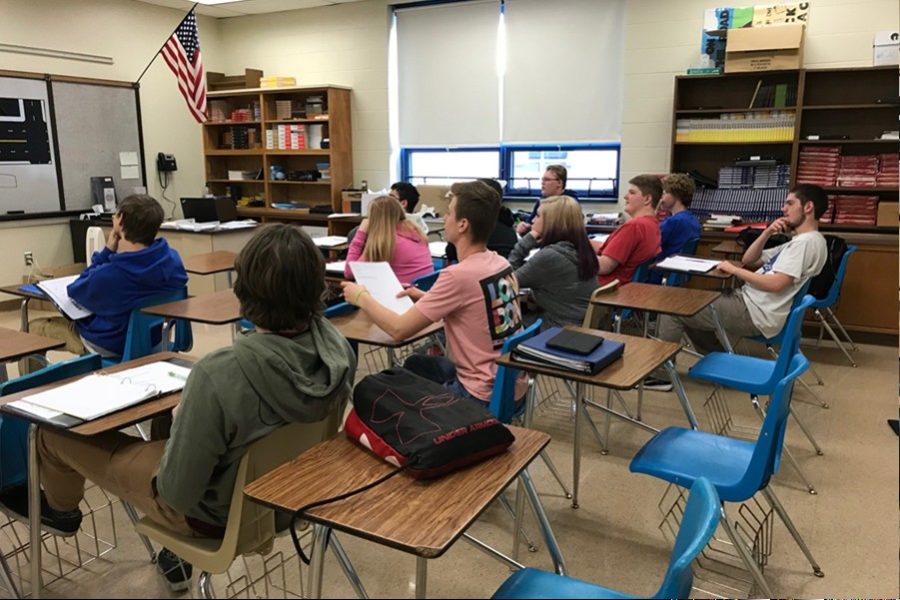BASD administrators not put off by SPP scores
B-A ranks third in the county
Bellwood-Antis recently received a School Performance Profile that ranked it No. 3 in the county.
December 11, 2017
If Superintendent Dr. Thomas McInroy has a vision for students at Bellwood-Antis, it’s to find their way in the real world. To do that, he said, some degree of assessment is necessary.
“When you guys leave us, I want you to knock everybody’s socks off and get the best job in the world,” he said. “In order to really do that, we have to assess what we’re teaching, when we’re teaching it, and how we’re teaching it.”
However, test scores aren’t the only measure for student success in play at Bellwood-Antis, which is why District officials weren’t terribly alarmed when School Performance Profiles were released last month.
Any school district’s goal is to set its students up for success, and the Pennsylvania Department of Education’s School Performance Profiles (SPPs) are meant to measure a school’s ability to do just that. Each November, the schools are judged primarily on their test scores (including the Keystones, PSSAs, SATs, etc.) and how well their students are making progress towards proficiency. The schools are also judged on academic improvement, graduation rate, and attendance rate.
Myers Elementary School received a score of 64.6, and the middle school received a score of 77.2. Bellwood-Antis High School was ranked third in Blair County, with a score of 65.6.
Second in the county is Holidaysburg Area High School with a score of 86, and first in the county is Tyrone Area High School with a score of 95.2.
The Altoona Mirror recently published a story about Tyrone’s apparent superiority over other schools in Blair County. The principal of Tyrone High School attributed its technology and focus on academics to its success. He also mentioned that staff members of the school take time to focus on the well-being of each individual student, intervening if the student seems to be falling behind.
However, the article also noted that school size and economics play a large role, as well.
How important are these scores, then, and what are they used for?
“I think the score is important in that we can track our progress from one year to the next. As over 80% of the score is based on PSSA performance, essentially it measures our success on that exam,” said middle school Principal Dr. Donald Wagner. “Generally, PDE (the Pennsylvania Department of Education) uses it as a means to assess the effectiveness of schools.”
According to Dr. McInroy, the PSSA scores are not being used correctly. “The PSSAs, when they first came out, were not to be used as an evaluation tool of a teacher’s ability because it’s a snapshot. It is one day in 180 days of education that we’re looking to see ‘What do these kids know?’ on that day,” he said. Essentially, the PSSAs were originally meant to be used as a tool to help teachers evaluate their teaching strategies, but are now being used to judge the academic process of schools.
In addition to being used as a value to compare school districts, the SPP scores are used to assess the performances of teachers and principals. “Because it is used in the evaluation of teachers and principals, it certainly is important. I think the more important question is about the credibility of the score,” said Dr. Terri Harpster, principal of Myers Elementary School. “In other words, does the score reliably represent the quality of the learning and educational experiences of the students who attend the school?”
Administration throughout the district think not. “I believe the current system is not only unfair, but offensive to students, their parents and all educators,” continued Dr. Harpster on the subject of whether or not schools are rated fairly. “In no other profession is an assessment of kids, beginning at the age of nine, used to evaluate those providing the service. It over-simplifies the complex work of teaching and complex social activity we call learning.”
Dr. McInroy calls for a return to how we used to do education. This would involve allowing principals to be the ones to evaluate how the teachers are teaching. “I think that is the best way to evaluate how well a school is doing…Let the professionals be professionals,” he stated simply.
Others see some merit in the SPP scores. “I believe that the numbers used to form SPP are consistent across the state,” said high school Principal Mr. Richard Schreier. Like the others, however, he does not believe that the scores accurately report all a school has to offer.
Dr. Wagner believes that the scores can best be used to evaluate a school’s performance on standardized test. “The vast majority of the SPP is based on the scores obtained from the PSSA. Therefore, I think the SPP is fair if it is reviewing with that understanding,” he said.
Fair or not, however, the SPP scores cannot be ignored. “The score is certainly a concern because it is publicized as a fair representation of the quality of a school and district. Citizens across our country and region may look at the school and assume it is a reliable measure of the quality of education,” said Dr. Harpster.
Is the school district satisfied with our scores, then, and if not, how will they improve?
At Myers, teachers and administrators are currently working to improve their score by focusing on math and reading skills. The middle school received the highest score of all the middle schools in the county.
“An SPP number of 65.6 is the lowest we have had in a couple years. As a school leader we are never satisfied and look toward continuous improvement,” said Mr. Schreier. The areas the high school most needs to improve on are helping historically low-achieving students and closing the achievement gap.
Despite this, there are some important things about a school and its students that a numeric score cannot account for.
Dr. McInroy is of the opinion that the arts can be just as important as academics. “I think the arts are critically important to making well rounded people who will be successful when they leave us, because they will have vast experiences that will pay off dividends in their future. To get away from that is a mistake,” he said.
The SPP scores also cannot measure the quality of a school’s community. “PSSA and Keystone exams don’t measure the many aspects of an effective school, such as: extra-curricular activities, support services, financial expenditures, classroom environment, and community relations,” said Dr. Wagner.
As for the students, test scores are not the only proof of a student’s development as an individual. “A test score on one or two days of school does not tell the story of the development and success of our students, teachers, and school community,” said Mr. Schreier.
One of the most important goals of a school is impossible to measure in a score—that is, to teach its students skills that will allow them to thrive beyond high school. Dr. Harpster described it best: “How do we measure students’ ability to conduct research and vet information sources? How do we measure students’ abilities to engage in rigorous collaborative processes that involve creation and production? How do we measure students’ ability to respectfully engage in debate about divisive issues? How do we measure students’ willingness to serve others and develop empathy? How do we measure students’ courage to stand up for others or for something they believe in?”






